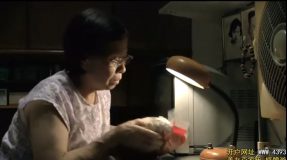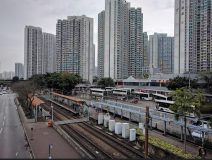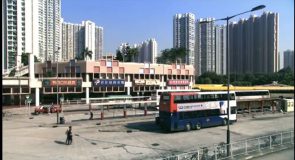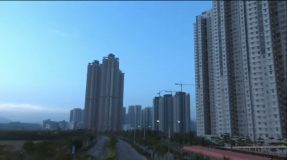THE WAY WE ARE, DIR. ANN HUI (2008)
Tin Yiu Estate, Yuen Long District, Hong Kong
The Way We Are (天水圍的日與夜) takes places in Tin Yiu Estate, Tin Shui Wai. Homes of 300,000 people.
Shot on HD in a documentary style, the film delineates the everyday lives of 貴姐, her son 家安 and their neighbour 阿婆 through the eyes of a voyeur.
 With music in the background, 阿婆 finds her $320 dried mushrooms*. Scene from The Way We Are 2008, directed by Ann Hui.
With music in the background, 阿婆 finds her $320 dried mushrooms*. Scene from The Way We Are 2008, directed by Ann Hui.
Tin Yiu Estate presented in the film is nearly the same as experienced in reality. According to Hui, people in the backgrounds were those living there. The two flats being filmed, including the furniture, belonged to the residents of Tin Yiu Estate. They left the details untouched. Nothing was artificially changed or built. Moreover, Hui approached the place with a pace that ebbs and flows as naturally as time, utilising sparing amounts of music and shots on static objects.


Upper: View of Tin Yiu Bus Terminus, Tin Yiu Estate, Yuen Long, Hong Kong. Photo taken by Bill Bertram on Google Map. Lower: View of Tin Yiu Bus Terminus, Tin Yiu Estate, Yuen Long, Hong Kong. Scene from The Way We Are 2008, directed by Ann Hui.
Released in 2008, Tin Shui Wai at the time was all over the headlines -“A besieged city that breeds murders”. This public attention was perhaps the reason Hui chose Tin Shui Wai.
However, in the film Tin Yiu Estate is presented like any anonymous, nondescript, ordinary public housing estate in Hong Kong. There is no direct implication linked to Tin Shui Wai. At the outset of the story, the entire estate is filmed before narrowing the focus on the home of 貴姐 as a microcosm of the city1. The Way We Are tells a story that can happen in any public housing estates, on any grassroots citizens’ days and nights.
View of the entire Tin Yiu Estate in the morning*. Scene from The Way We Are 2008, directed by Ann Hui.
By presenting Tin Yiu Estate in such ways, the audience is not cajoled into the role of active participant to speculate the next climax. They react naturally, pause and ponder. They reminisce about the characters’ and their own presents and pasts, summon up profound but indistinct evocations. They own the space and become the characters themselves. To me, it brings me back to my childhood home, Shek Lei Estate. With the same mat bought form “two dollar shop”, the same floor plan, the same 阿婆 I would meet in the lobby.
At two points in this film, Hui cuts to old, sepia-coated photographs of Hong Kong. The photographs in total last for less than two minutes. Yet, they create a strong contrast to the plain everyday lives presented in the rest of the film.
Beneath the serene, simple, mundane present Hui purposely created that we all experience, there is something ineffable, something that hangs in the air, something on the cusp of disappearing, something that makes us the way we are – or perhaps more accurately, the way we were2. Through the contrast the film quietly brings out the imbrication of the past and the present.
The traces of the past may yet still be ordinary, but they add weight and depth to the ordinary people’s lives. They are not the unfortunate people living in Tin Shui Wai. They are people with stories. Stories that caress out hearts.
“Life is hard.”
“How hard can it be?” — 貴姐
— Wong Tsz Kiu 3035941447
Notes:
1 Pamela Roberton Wojcik, “The Apartment Complex: Urban Living and Global Screen Culture” (2018) :4
2 Ron Ma, Review comment on Letterboxd, 26 Aug 2020
*You may watch the full video clips via the links
A thoughtful reflection on the film. I appreciate your description of the estate – anonymous, nondescript and the pace presented “naturally” as if in real-time. Perhaps the key to your analytical reflection here is why and how is it “nearly the same as experienced in reality” but not quite. You raise other good points such as the notion of the estate as a microcosm of the city, and your own experience of similar spaces such as the “two-dollar” store, the apartment (or do you mean building?) floor plan, and the lift lobby. What are your observations of these spaces as they are presented in the film, as they are experienced or used in real life, and from your memory of your own experience living in similar spaces? What about the contrast between the past and present as visually narrated (still photographs vs moving reel, and color tonality) in the film, as you allude to when you mention the old, sepia photographs of Hong Kong. A deeper discussion on at least one or two of these spaces will be meaningful in understanding the implications of the film’s docu-fictional character. Do also cite your sources fully, including the newspaper reference on Tin Shui Wai, and the interview with Ann Hui.